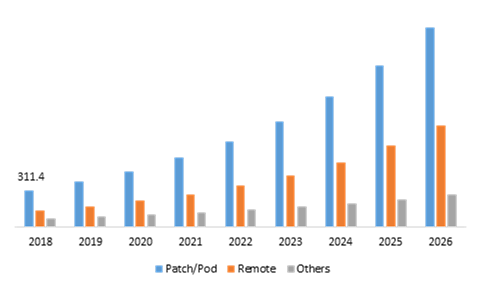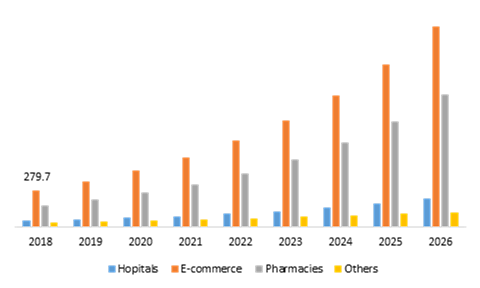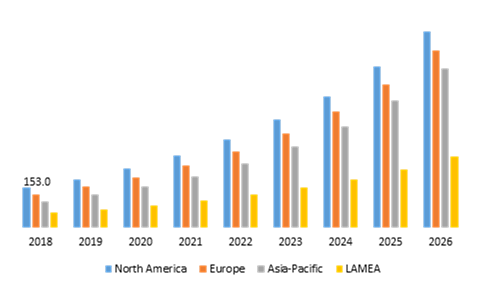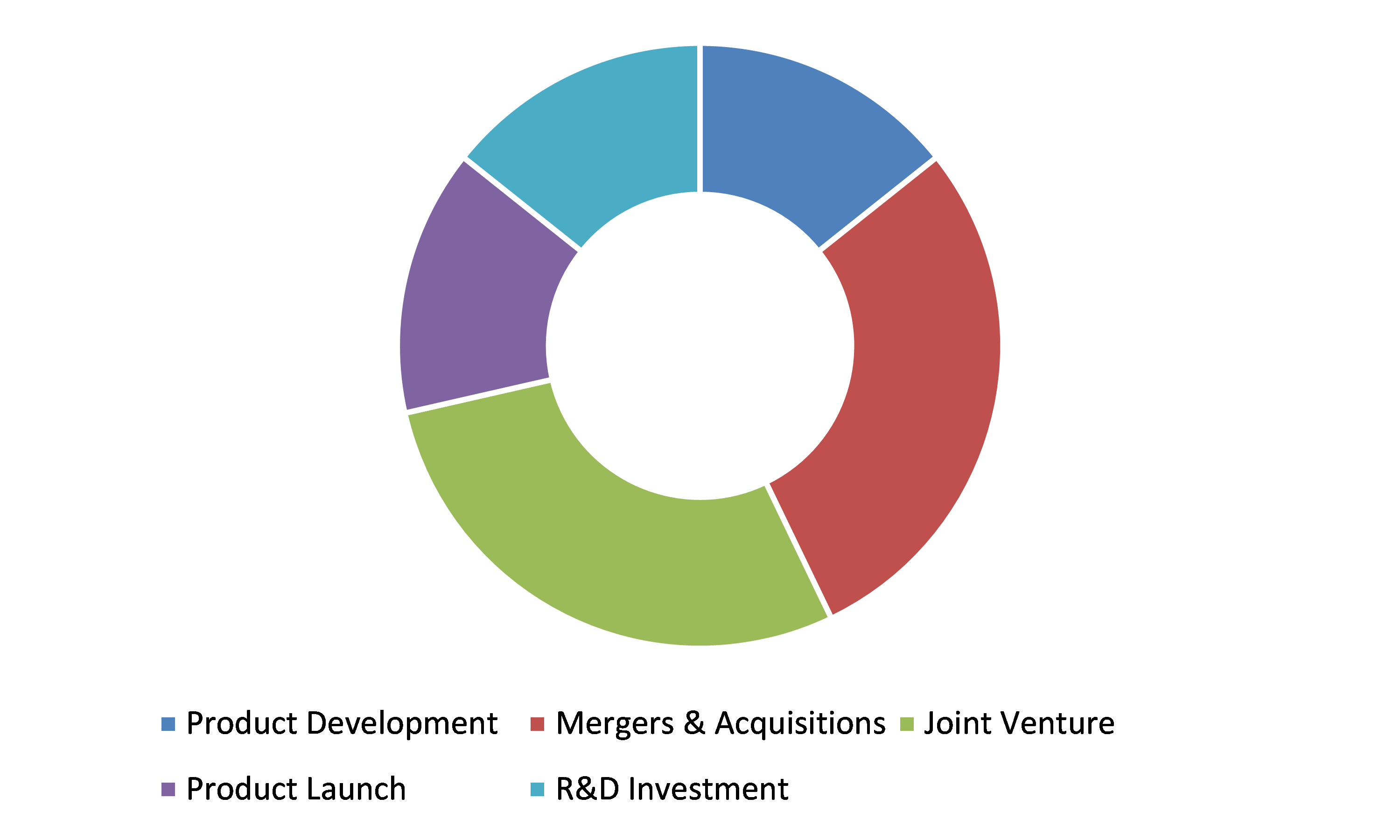Tubeless Insulin Pump Market Report
RA00031
Tubeless Insulin Pump Market by Component (Pod/Patch, Remote, Others), By Distribution Channel (Pharmacies, e-Commerce, Hospitals, Others), Regional Outlook (North America, Europe, Asia-Pacific, LAMEA), Global Opportunity Analysis and Industry Forecast, 2019-2026
Update Available On-Demand
Tubeless Insulin Pump Market Growth 2026:
Global tubeless insulin pump market growth is projected to a CAGR of 23.4% generating a revenue of $ 2,837.6 million by 2026.
A tubeless insulin pump is a convenient, effective and portable device that aids in controlling the blood glucose level of the user. The tubeless insulin pump market is estimated to have significant growth in the forecast period. Increasing diabetic cases, especially among geriatric patients, will accelerate the acceptance of tubeless insulin pumps, as they take better care of the patients and control the disease consequences.
Tubeless Insulin Pump Market Drivers:
Rising diabetic cases and the technological advancements in the tubeless insulin pump market is anticipated to boost the growth of tubeless insulin pump market
The key factor driving the growth of the tubeless insulin pump market is the growing number of diabetic cases. The diabetes is found not only in geriatric population, but also in children and mid-aged population. According to the World Health Organization (WHO), around 1.6 million deaths occurred in 2016, due to diabetes. The market is further anticipated to grow owing to the technological advancements in the tubeless insulin pump market, such as the incorporation of smart technologies in insulin pods and remotes. Traditional invasive insulin pumps cause injuries and infections to patients. Due to this, the patients are preferring the tubeless insulin pumps, which are not harmful to the patient’s body. Moreover, increasing government initiatives to raise awareness globally about diabetes management and Medicare policies are set to boost the overall market growth during the projected period.
Market Restraints:
The high cost of the tubeless insulin pump and increased risk of diabetic ketoacidosis are some of the major threats for the growth of tubeless insulin pump market
The high cost of the tubeless insulin pumps acts as a significant threat to the growth of the tubeless insulin pump market. Also, there are high chances of getting diabetic ketoacidosis for the user, in case of pump failures. This can happen in case of battery drainage, insulin inactivation by heat exposure, or in the presence of a dry tank. In these cases, insulin spills or the catheter becomes kinked to avoid the delivery. Due to this, the patient has to face a lot of consequences including skin diseases.
Tubeless Insulin Pump Market Segment, by Component:

The pods' segment is predicted to be most profitable till the end of 2026
Source: Research Dive Analysis
The market size for pods was $311.4 million in 2018 and is expected to grow at a CAGR of 23.6% during the anticipated period. The pod is a lightweight, disposable vessel that can be attached anywhere on the user’s body and can be carried up to three days of nonstop insulin, wherein the pod will check the blood sugar level and inject the insulin whenever required. The pods are normally pre-filled with insulin which is inserted by a small, flexible cannula to deliver insulin to the user so that the patient can get use them along with their pods for checking their insulin level. This kit also consists of a pump that can be operated via the phone, with advanced devices such as Bluetooth-enabled devices, wearables, and others.
Tubeless Insulin Pump Market, by Distribution channel

E-commerce segment will possess high investment opportunities in the coming future.
Source: Research Dive Analysis
The Ecommerce distribution channel segment has become one of the most commonly used channels for the sales of tubeless insulin pumps. The revenue generated by the product sales through this channel in 2018 was $279.7 million and is estimated to witness growth at more than 23.5% CAGR till 2026. The consumers are highly attracted to the economic benefits offered by these channels and are preferring over purchases through the traditional offline channels.
Tubeless Insulin Pump Market, by Region
North America region will have enormous opportunities for the market investors to grow over the coming years

Source: Research Dive Analysis
North America's regional market held the largest tubeless insulin pump market share in 2018. This regional market held the market size of $184.7 million in 2018 and is expected to exceed $924.5 million by 2026, at a CAGR of 22.3%. Due to the lack of physical activity and increase in the number of old age population among the people in this region can be the biggest region for the increase in the diabetic population. U.S. and Canada are predicted to witness a significant increase in the diabetic population over the coming years, which will further drive the market for more investment opportunities in the tubeless insulin pump market during the forecast period.
Key participants and competitive landscape analysis of Global Tubeless insulin pump Market:
Technological enhancement and agreements are the most common strategies followed by the market players

Source: Research Dive Analysis
Some of the tubeless Insulin Pump market players are Medtrum Technologies Inc, Insulet Corporation, Debiotech, Johnson & Johnson, Rosh Holding AG, Cellnovo Group SA, Spring Health Solution Ltd, Veleritas, CeQur SA, and Abbott Diabetes Care among many others. The competitive landscape analysis of tubeless insulin pump market will be analyzed among the above mentioned players.
Recent Developments in Tubeless Insulin Pump Market:
In 2016, a U.S based pharmacy firm Insulet Corporation and another company named Eli Lilly & Company entered into an agreement to build a new model of tubeless Omni pod insulin delivery system to distribute highly concentrated U200 and U500 insulin formulations. Therefore, it is undeniable that collaborations witnessed across the pharmaceutical and healthcare sector that had a significant impact on the overall business.
Scope The Research Report:
| Aspect | Particulars |
| Historical Market Estimations | 2016-2018 |
| Base Year for Market Estimation | 2018 |
| Forecast timeline for Market Projection | 2019-2026 |
| Geographical Scope | North America, Europe, Asia-Pacific, LAMEA |
| Segmentation by Component |
|
| Segmentation by Distribution Channel |
|
| Key Countries covered | U.S., Canada, Germany, France, Spain, Russia, Japan, China, India, South Korea, Australia, Brazil, and Saudi Arabia |
| Key Companies Profiled |
|
Source: Research Dive Analysis
Q1. What is the market size of tubeless insulin pump?
A. The global market size of tubeless insulin pump was over $527.8 Million in 2018, and is further anticipated to reach $23.4 million by 2026.
Q2. Who are the leading companies in the tubeless insulin pump market?
A. Johnson & Johnson, Debiotech and Veleritas are some of the key players in the global aerospace maintenance chemical market.
Q3. Which region possesses greater investment opportunities in the coming future?
A. North America possesses great investment opportunities for investors to witness the most promising growth in the coming years.
Q4. What is the growth rate of North America?
A. North America tubeless insulin pump market is projected to grow at 22.3% CAGR during the forecast period.
Q5. What are the strategies opted by the leading players in this market?
A. Technological enhancement and agreements are the key strategies opted by the operating companies in this market.
Q6. Which companies are investing more in R&D practices?
A. Insulet Corporation, Cellnovo Group SA, Johnson & Johnson are the companies investing more in R&D activities for developing new products and technologies.
1. Research Methodology
1.1. Desk Research
1.2. Real time insights and validation
1.3. Forecast model
1.4. Assumptions and forecast parameters
1.4.1. Assumptions
1.4.2. Forecast parameters
1.5. Data sources
1.5.1. Primary
1.5.2. Secondary
2. Executive Summary
2.1. 360° summary
2.2. Component trends
2.3. Distribution channel trends
3. Market overview
3.1. Market segmentation & definitions
3.2. Key takeaways
3.2.1. Top investment pockets
3.2.2. Top winning strategies
3.3. Porter’s five forces analysis
3.3.1. Bargaining power of consumers
3.3.2. Bargaining power of suppliers
3.3.3. Threat of new entrants
3.3.4. Threat of substitutes
3.3.5. Competitive rivalry in the market
3.4. Market dynamics
3.4.1. Drivers
3.4.2. Restraints
3.4.3. Opportunities
3.5. Technology landscape
3.6. Regulatory landscape
3.7. Patent landscape
3.8. Pricing overview
3.8.1. Component
3.8.2. Distribution Channel
3.9. Market value chain analysis
3.9.1. Stress point analysis
3.9.2. Distribution channel analysis
3.9.3. Operating vendors
3.9.3.1. Raw material suppliers
3.9.3.2. Product manufacturers
3.9.3.3. Product distributors
3.10. Strategic overview
4. Tubeless Insulin Pump Market, by Component
4.1. Pod/Patch
4.1.1. Market size and forecast, by region, 2016-2026
4.1.2. Comparative market share analysis, 2018 & 2026
4.2. Remote
4.2.1. Market size and forecast, by region, 2016-2026
4.2.2. Comparative market share analysis, 2018 & 2026
4.3. Others
4.3.1. Market size and forecast, by region, 2016-2026
4.3.2. Comparative market share analysis, 2018 & 2026
5. Tubeless Insulin Pump Market, by Distribution Channel
5.1. Ecommerce
5.1.1. Market size and forecast, by region, 2016-2026
5.1.2. Comparative market share analysis, 2018 & 2026
5.2. Pharmacy
5.2.1. Market size and forecast, by region, 2016-2026
5.2.2. Comparative market share analysis, 2018 & 2026
5.3. Hospital
5.3.1. Market size and forecast, by region, 2016-2026
5.3.2. Comparative market share analysis, 2018 & 2026
5.4. Others
5.4.1. Market size and forecast, by region, 2016-2026
5.4.2. Comparative market share analysis, 2018 & 2026
6. Tubeless Insulin Pump Market, by Region
6.1. North America
6.1.1. Market size and forecast, by component, 2016-2026
6.1.2. Market size and forecast, by distribution channel, 2016-2026
6.1.3. Market size and forecast, by country, 2016-2026
6.1.4. Comparative market share analysis, 2018 & 2026
6.1.5. U.S.
6.1.5.1. Market size and forecast, by component, 2016-2026
6.1.5.2. Market size and forecast, by distribution channel, 2016-2026
6.1.5.3. Comparative market share analysis, 2018 & 2026
6.1.6. Canada
6.1.6.1. Market size and forecast, by component, 2016-2026
6.1.6.2. Market size and forecast, by distribution channel, 2016-2026
6.1.6.3. Comparative market share analysis, 2018 & 2026
6.1.7. Mexico
6.1.7.1. Market size and forecast, by component, 2016-2026
6.1.7.2. Market size and forecast, by distribution channel, 2016-2026
6.1.7.3. Comparative market share analysis, 2018 & 2026
6.2. Europe
6.2.1. Market size and forecast, by component, 2016-2026
6.2.2. Market size and forecast, by distribution channel, 2016-2026
6.2.3. Market size and forecast, by country, 2016-2026
6.2.4. Comparative market share analysis, 2018 & 2026
6.2.5. Germany
6.2.5.1. Market size and forecast, by component, 2016-2026
6.2.5.2. Market size and forecast, by distribution channel, 2016-2026
6.2.5.3. Comparative market share analysis, 2018 & 2026
6.2.6. France
6.2.6.1. Market size and forecast, by component, 2016-2026
6.2.6.2. Market size and forecast, by distribution channel, 2016-2026
6.2.6.3. Comparative market share analysis, 2018 & 2026
6.2.7. UK
6.2.7.1. Market size and forecast, by component, 2016-2026
6.2.7.2. Market size and forecast, by distribution channel, 2016-2026
6.2.7.3. Comparative market share analysis, 2018 & 2026
6.2.8. Italy
6.2.8.1. Market size and forecast, by component, 2016-2026
6.2.8.2. Market size and forecast, by distribution channel, 2016-2026
6.2.8.3. Comparative market share analysis, 2018 & 2026
6.2.9. Spain
6.2.9.1. Market size and forecast, by component, 2016-2026
6.2.9.2. Market size and forecast, by distribution channel, 2016-2026
6.2.9.3. Comparative market share analysis, 2018 & 2026
6.2.10. Russia
6.2.10.1. Market size and forecast, by component, 2016-2026
6.2.10.2. Market size and forecast, by distribution channel, 2016-2026
6.2.10.3. Comparative market share analysis, 2018 & 2026
6.2.11. Rest of Europe
6.2.11.1. Market size and forecast, by component, 2016-2026
6.2.11.2. Market size and forecast, by distribution channel, 2016-2026
6.2.11.3. Comparative market share analysis, 2018 & 2026
6.3. Asia-Pacific
6.3.1. Market size and forecast, by component, 2016-2026
6.3.2. Market size and forecast, by distribution channel, 2016-2026
6.3.3. Market size and forecast, by country, 2016-2026
6.3.4. Comparative market share analysis, 2018 & 2026
6.3.5. China
6.3.5.1. Market size and forecast, by component, 2016-2026
6.3.5.2. Market size and forecast, by distribution channel, 2016-2026
6.3.5.3. Comparative market share analysis, 2018 & 2026
6.3.6. Japan
6.3.6.1. Market size and forecast, by component, 2016-2026
6.3.6.2. Market size and forecast, by distribution channel, 2016-2026
6.3.6.3. Comparative market share analysis, 2018 & 2026
6.3.7. India
6.3.7.1. Market size and forecast, by component, 2016-2026
6.3.7.2. Market size and forecast, by distribution channel, 2016-2026
6.3.7.3. Comparative market share analysis, 2018 & 2026
6.3.8. South Korea
6.3.8.1. Market size and forecast, by component, 2016-2026
6.3.8.2. Market size and forecast, by distribution channel, 2016-2026
6.3.8.3. Comparative market share analysis, 2018 & 2026
6.3.9. Australia
6.3.9.1. Market size and forecast, by component, 2016-2026
6.3.9.2. Market size and forecast, by distribution channel, 2016-2026
6.3.9.3. Comparative market share analysis, 2018 & 2026
6.3.10. Rest of Asia-Pacific
6.3.10.1. Market size and forecast, by component, 2016-2026
6.3.10.2. Market size and forecast, by distribution channel, 2016-2026
6.3.10.3. Comparative market share analysis, 2018 & 2026
6.4. LAMEA
6.4.1. Market size and forecast, by component, 2016-2026
6.4.2. Market size and forecast, by distribution channel, 2016-2026
6.4.3. Market size and forecast, by country, 2016-2026
6.4.4. Comparative market share analysis, 2018 & 2026
6.4.5. Brazil
6.4.5.1. Market size and forecast, by component, 2016-2026
6.4.5.2. Market size and forecast, by distribution channel, 2016-2026
6.4.5.3. Comparative market share analysis, 2018 & 2026
6.4.6. Saudi Arabia
6.4.6.1. Market size and forecast, by component, 2016-2026
6.4.6.2. Market size and forecast, by distribution channel, 2016-2026
6.4.6.3. Comparative market share analysis, 2018 & 2026
6.4.7. South Africa
6.4.7.1. Market size and forecast, by component, 2016-2026
6.4.7.2. Market size and forecast, by distribution channel, 2016-2026
6.4.7.3. Comparative market share analysis, 2018 & 2026
6.4.8. Rest of LAMEA
6.4.8.1. Market size and forecast, by component, 2016-2026
6.4.8.2. Market size and forecast, by distribution channel, 2016-2026
6.4.8.3. Comparative market share analysis, 2018 & 2026
7. Company profiles
7.1. Medtrum Technologies Inc
7.1.1. Business overview
7.1.2. Financial performance
7.1.3. Product portfolio
7.1.4. Recent strategic moves & developments
7.1.5. SWOT analysis
7.2. Insulet Corporation
7.2.1. Business overview
7.2.2. Financial performance
7.2.3. Product portfolio
7.2.4. Recent strategic moves & developments
7.2.5. SWOT analysis
7.3. Debiotic
7.3.1. Business overview
7.3.2. Financial performance
7.3.3. Product portfolio
7.3.4. Recent strategic moves & developments
7.3.5. SWOT analysis
7.4. Johnson & Johnson
7.4.1. Business overview
7.4.2. Financial performance
7.4.3. Product portfolio
7.4.4. Recent strategic moves & developments
7.4.5. SWOT analysis
7.5. Rosh Holding AG
7.5.1. Business overview
7.5.2. Financial performance
7.5.3. Product portfolio
7.5.4. Recent strategic moves & developments
7.5.5. SWOT analysis
7.6. Cellnovo Group SA
7.6.1. Business overview
7.6.2. Financial performance
7.6.3. Product portfolio
7.6.4. Recent strategic moves & developments
7.6.5. SWOT analysis
7.7. Spring Health Solution Ltd
7.7.1. Business overview
7.7.2. Financial performance
7.7.3. Product portfolio
7.7.4. Recent strategic moves & developments
7.7.5. SWOT analysis
7.8. Veleritas
7.8.1. Business overview
7.8.2. Financial performance
7.8.3. Product portfolio
7.8.4. Recent strategic moves & developments
7.8.5. SWOT analysis
7.9. CeQur SA
7.9.1. Business overview
7.9.2. Financial performance
7.9.3. Product portfolio
7.9.4. Recent strategic moves & developments
7.9.5. SWOT analysis
7.10. Abbott Diabetes Care
7.10.1. Business overview
7.10.2. Financial performance
7.10.3. Product portfolio
7.10.4. Recent strategic moves & developments
7.10.5. SWOT analysis
Over the past few decades, a million of people with diabetes have counted on insulin pumps to measure the drug that keeps the blood sugar in check. Looking at the current world scenario, there are around 371 million people that are affected by diabetes. This states that a huge amount of the world population is suffering from this chronic disease that is caused due to inappropriate functioning of pancreas. Diabetes is responsible for the production of insulin hormones. The tubeless insulin pump is a convenient, effective and portable device that aids in controlling the blood glucose level of the patient.
Benefits of Tubeless Insulin Pump
The tubeless insulin pump is flexible medical device that is used in controlling the blood glucose level of the user. The device helps diabetes patients get rid of daily dosage of multiple injections. In addition, it offers a constant, controlled flow of insulin into the body and have gained popularity since past few years. The tubeless insulin pump offers significant benefits such as more accuracy than shots, improves A1c levels, and easy to handle.
Tubeless insulin pump has been found valuable for those who have hypoglycemia, as it helps in having fewer blood sugar levels. Being a vital component in the diabetic health, this insulin pump also benefits in managing early morning high blood sugar, also called the “dawn phenomenon.” An insulin pump can help fix this owing to its feasibility to give specific doses of one’s choice at every single hour of the day. This cannot be accomplished with insulin pens.
Since, tubeless insulin pump is essential in keeping the blood sugar levels in control, its chief benefit is that it can be integrated with CGMS. In order to indicate low blood sugars, alarms can also be initiated in the device. When fully understood the working of tubeless insulin pump, the diabetic patient can have a much tighter control of the diabetes.
People have to adjust to their daily lives when making use of traditional insulin pumps to manage their diabetes. Insulet Corporation has changed that by introducing Omnipod in the tubeless insulin pump industry. They have made diabetic patients adapt their day-to-day lives to live uncomfortably with a tubed pump.
Application Areas of Tubeless Insulin Pump Market
From hospitals to pharmacies and even e-commerce, the use of tubeless insulin pump is progressively gaining importance in many industrial sectors. In 2016, Eli Lilly & Company and a U.S. based pharmaceutical firm, Insulet Corporation signed an agreement for developing a new tubeless insulin delivery system; Omnipod. The purpose was to distribute highly concentrated U200 and U500 formulations of insulin. The prominent players of the market are implementing several strategies such as joint ventures, mergers, and acquisitions to develop a strong position in the global market. Moreover, tubeless insulin pumps have become increasingly connected and flexible over the past few years in the e-commerce sector. The consumers are highly attracted to the economic benefits offered by these channels and are preferring over purchases through the traditional offline channels.
In 2019, the FDA granted its first-ever marketing authorization to U.S based medical device manufacturer, Tandem Diabetes Care for its interoperable insulin pump manufactured. The insulin pump is a compatible automatic insulin dosing system with blood glucose meters, continuous glucose monitors, and used for other diabetes therapy. The “T Slim X2” insulin pump is the first of a novel medical device group named ‘ACE infusion pumps’ (Alternate Controller Enabled). The device can be used by both children and adults with diabetes. The device can independently infuse insulin on its own and once connected can automatically receive insulin dosing commands from a diabetes management device.
Future of Tubeless Insulin Pump Market
Global tubeless insulin pump market is quite competitive in nature. Several applications of tubeless insulin pump in hospitals, e-commerce, pharmacies, and others are thrusting the growth of tubeless insulin pump market.
Over the years, insulin pumps have remained largely unchanged, leaving the device ripe for innovation. People using traditional insulin pumps often have to adjust their everyday lives to manage their diabetes for living comfortably. Today, with several research and development in the medical field, the tubeless insulin pump has made it simpler for the people with diabetes, and Omnipod is one such device. It is a Bluetooth-enabled touchscreen and waterproof tubeless insulin device. The small device is a lightweight, disposable pod that can be positioned anywhere on the user’s body and can be worn up to three days. The growing occurrence of diabetes cases in patients and its simpler to use benefit is expected to boost the demand for tubeless insulin pump market in the near future.
Rising population of diabetes cases, decrease in demand for the traditional insulin pumps that caused infection, and technology advancements is expected to drive the market growth in the upcoming years. This can be backed by statistics offered by a research report from Research Dive. The report states, the global tubeless insulin pump market is expected to grow with a growth rate of 23.4% from 2019 to 2026. The report also highlights the top players operating in this market are:
- Medtrum Technologies Inc
- Insulet Corporation
- Debiotech
- Johnson & Johnson
- Rosh Holding AG
- Cellnovo Group SA
- Veleritas
- Abbott Diabetes Care
- Spring Health Solution Ltd.
- CeQur SA.
On the other hand, increasing government initiatives to raise awareness globally about diabetes management and Medicare policies are sure to fuel the market growth. Hence, it is clear that be it e-commerce industry, hospitals or pharma companies the applications of tubeless insulin pump are rising day by day and will surely boost the market growth in the coming future.
Personalize this research
- Triangulate with your own data
- Request your format and definition
- Get a deeper dive on a specific application, geography, customer or competitor
- + 1-888-961-4454 Toll - Free
- support@researchdive.com

